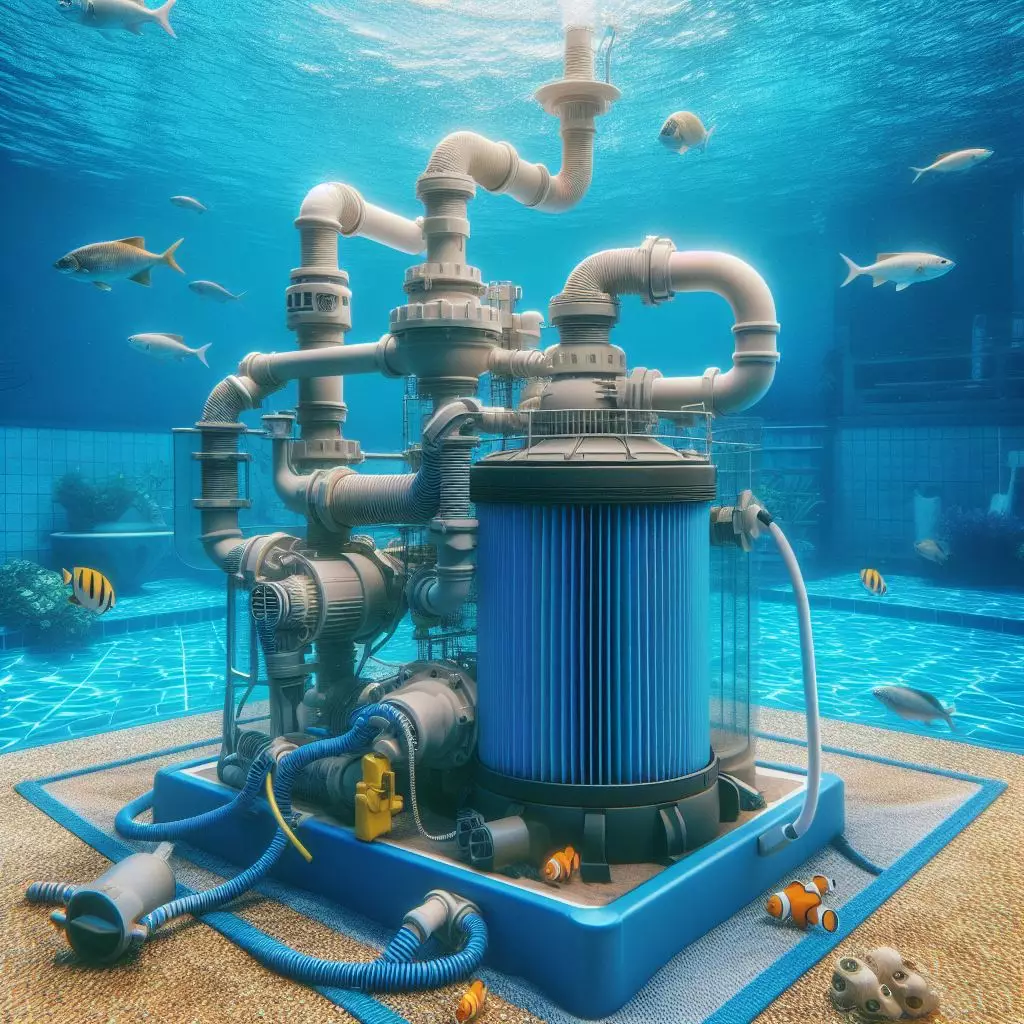Imagine this: you wake up to a piercing noise coming from your backyard, like nails on a chalkboard times ten. You run outside and find the noise is coming from your pool pump. Turning it off stops the noise, but you know you’ll be shopping for a new pool pump the next day. Whether this scenario is familiar, your pump suddenly died, or you need a new pump for a new pool, you want to choose the best one for your pool and budget. Remember, this is a long-term investment in your pool’s health. The key is to understand your pool’s needs and what features to look for.

The Role of a Pool Pump
The pool pump is the heart of your pool’s plumbing system. Without it, there would be no circulation, and water wouldn’t flow through the filtration system to be cleaned properly. This would result in a dirty, stagnant pool, essentially a cement pond you wouldn’t want to swim in.
Pool Pump Anatomy
Before looking for a new pump, it helps to understand how it works. A pool pump consists of three main parts: the housing, the impeller, and the motor.
- Housing: It comprises a bucket and basket with a clear lid. Pool water is sucked into this bucket, through the basket, and then to the filter.
- Impeller: A fast-spinning, inverted blade that draws water in and pushes it through to the filter.
- Motor: Attached to the back of the pump housing, its sole purpose is to spin the impeller. It’s sometimes referred to as the pump and motor, or just the pump.
Types of Pool Pumps
Since their invention, pool pumps have come a long way, evolving from a single type to three types available on the market.
Single-Speed Pumps
This is the earliest type. The single-speed pump’s motor spins the impeller at one speed according to the motor’s horsepower. If you are replacing a single-speed pump, we recommend upgrading to at least a dual-speed pump or better. They are more efficient and circulate the pool water more quickly. However, note that some states, such as Arizona and California, prohibit the installation of new single-speed pumps. Check your state’s regulations before purchasing a new pump.
Dual-Speed Pumps
As the name suggests, these pumps have two speeds: low and high. The high speed is equivalent to a single-speed pump. The low speed uses less energy but may not be as efficient at water turnover, depending on your pool’s volume.
Variable-Speed Pumps
Yes, these pumps are more expensive than single-speed or dual-speed pumps, but they are a long-term investment. Variable-speed pumps use a permanent magnet motor, like those in electric cars. This type of motor generates less friction than induction motors, resulting in higher efficiency. Variable-speed pumps also consume less power, circulate water more quickly, and run at lower RPMs, making them quieter. You may even receive a utility rebate when purchasing one.
Features to Look For in a Pool Pump
Inground or Above Ground
You can find pumps for both above ground and inground pools. While they are usually interchangeable, it’s best to get a pool pump designed for your type of pool.
Horsepower
The more powerful your pool pump—the more horsepower it has—the faster it will turn the water over, so you can run it less often and for shorter periods. However, this depends on the size of your filter and the filtration system’s pipes. A pump with too much horsepower can overwhelm a small filter. If your system uses three-inch pipes, you can install a three-horsepower pump, which will work more quickly. But three horsepower can be too much for a small pool, wasting energy and costing more money. Choose a pump that won’t overwhelm the filtration system but still has enough horsepower to turn over your pool’s volume at an adequate rate.
Pump Housing Mount
You have two options: top mount or side mount. This indicates where the pool pump’s output—which leads into the filter—is located. If your filter’s intake is positioned above the pump, you need a top mount. If the filter intake is next to the pump, you need a side mount. Check your filter’s intake position before buying a pool pump to ensure the housing mount is in the correct place.
Pump Motor Voltage
Your pool pump can either be hardwired into your electrical system or require an outlet to plug into. Know this before buying your pump. You also need to determine whether the pump runs on 110 volts or 220 volts. Most above ground pools require a 110-volt pump. But you need to determine the voltage if you have an inground pool.
How to Choose the Right Size Pool Pump
To keep the pool water clean, all the water in your pool must be completely filtered at least once a day. This is called the turnover rate. Your pump must be large enough to turn over your pool’s full volume at least once per day.
Calculating Pump Turnover Rate
First, you need to calculate your pool volume. If unsure, use our pool calculator to figure it out:
- Use the pool calculator to determine your pool volume.
- Divide the pool volume by eight to determine the gallons per hour (GPH) that need to be pumped through the filter.
- Divide the GPH by 60 to calculate how many gallons per minute (GPM) need to be pumped for full turnover.
The formula is:
Total Pool Volume ÷ 8 = GPH
GPH ÷ 60 = GPM
Once you have these numbers, find a pump size that will accommodate the GPM required for your pool and turn over the pool’s water in one eight-hour period. If you need to choose a pump that pumps a little more than necessary, that’s fine. Just don’t go below the required GPM, and you’ll be okay.
Pool Pump Troubleshooting
It would be great if your pump ran forever without issues, but problems will arise. Knowing some common pump problems will help you address them when they occur.
Pump Leaks
The most common causes for pool pump leaks include a bad impeller housing O-ring, bad shaft seal, bad thread sealant, and shrunken threads on the discharge pipe. Most of these parts can be purchased and replaced easily at a fraction of the cost of calling a professional. Determine which part is leaking, take the system apart, replace it, and you will be back up and running in no time.
Pump Fails to Pull Water
When water isn’t being pulled into the pump, it can’t reach the filter and pass through the system properly. First, check the skimmer and pump baskets to ensure they’re not clogged. Next, check the impeller for debris impeding its movement. Open the pump and clear any debris. Another potential cause could be an air leak in the suction line. Since air has less mass than water, the pump will suck in air instead of water. Check the lines for leaks and patch any you find.
Motor Won’t Start
First, check the breaker to make sure it hasn’t been tripped. If the breaker is on but the pump still won’t turn on, it’s likely an electrical problem, and you may need to replace the motor. If you’re not comfortable working with electrical systems, calling a professional may be the best choice.
Motor Spontaneously Turns Off
If this happens, the motor is most likely overheated. Check the pump’s air vents to ensure nothing is obstructing airflow. If it continues, you may want to install something to shade the pump. If the problem persists, it could be an electrical issue, and you may want to call a professional unless you’re an electrician.
Motor is Making Noise
All pump motors will make some noise. But if your pump is making a racket that sounds different from normal, you could have a problem. If it’s just vibration, placing the pump on a rubber pad may do the trick. But if it’s a low, growling sound, the problem could be cavitation, meaning the pump isn’t getting enough water and is taking in air. First, prime the pool pump. If priming doesn’t stop the noise, check the intake lines for clogs and ensure none of the lines are leaking. If the pump is making a screaming noise, the bearings have likely gone bad. While the parts are inexpensive, fixing this requires a lot of labor as the motor needs to be shut off, disconnected, and disassembled. So have your tools ready for this one.
Don’t Hesitate to Call a Professional
If you can repair it and have the tools, go for it. DIY can save you money and give you the satisfaction of fixing something yourself. But if you lack the necessary knowledge or skills, or feel uncomfortable tackling a repair, call a professional. After all, this is the heart of your pool’s plumbing system. If you’re not confident, you could do more harm than good. A professional can take care of the repair correctly the first time. And you can watch and learn to handle the problem yourself next time.
Conclusion
Keeping the heart of your pool’s circulation system running isn’t difficult. As long as you choose the right kind of pool pump for your pool sand filter and pool volume, get the right size, and keep up with maintenance and repairs, your pump should last a long time. When it’s time to replace the pump, invest in the best pool pump you can, preferably a variable-speed model. It’ll pay for itself in energy savings and peace of mind.
